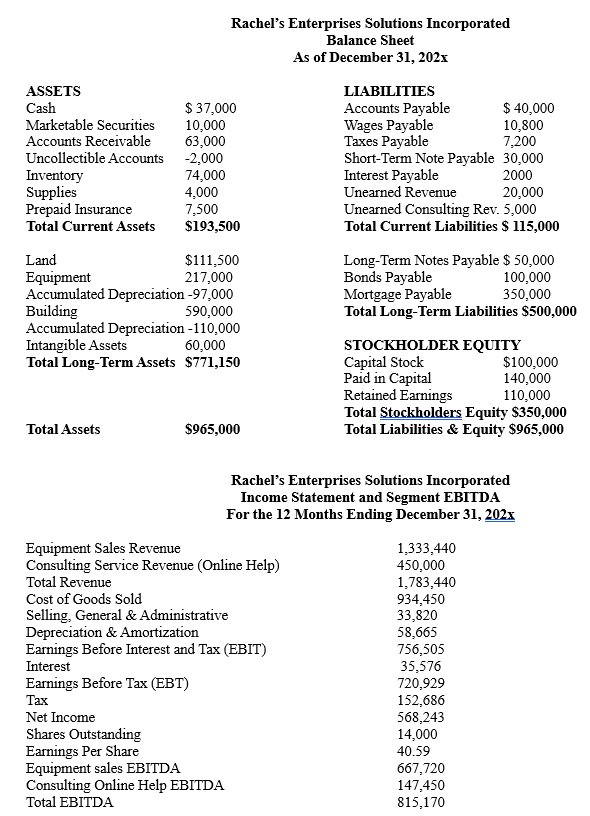Question
Rachel is putting together a growth plan for ESI. She is evaluating whether to substantially invest in company-owned equipment, and whether to outsource her online

Rachel is putting together a growth plan for ESI. She is evaluating whether to substantially invest in company-owned equipment, and whether to outsource her online services personnel to a call center in New Dehli, India. Rachel has asked for your analysis of the following two decisions facing ESI:
1. EQUIPMENT PURCHASE - ESI may decide to purchase outright additional computer equipment. ESI can continue to lease equipment from hardware vendors. Such a status quo decision comes with known margins and profitability metrics. The status quo is embodied in the income statement and balance sheet reported in 202x data given above. Rachel believes adding owned equipment to its existing leasing business will enable ESI to more fully utilize their fixed assets, grow faster and provide more customized services to a larger group of future clients. Rachel is proposing to purchase $500,000 of additional IT equipment. The equipment would be installed and prepared for use in the current year. When fully utilized the equipment would generate asset turnover of approximately 2x gross investment. It would likely take four years to reach full utilization. The useful life of equipment for accounting and tax purposes is 10 years. However, due to rapid life cycles in enterprise technology, after six years Rachel expects to sell the equipment for 10% of initial cost. The EBITDA (operating income plus depreciation and amortization) margin of business done with owned equipment is 1.1x the margin of business done with leased equipment.
2. OUTSOURCING ONLINE CONSULTANTS - Rachel may move her entire online service team to India. As she has tried to re-sign existing clients and win new business Rachel has been feeling pricing and margin pressure. For the time being Rachel has only re-signed or sought new business that matches her current margin profile. Rachel expects to be able to maintain the status quo in the online services business for several more years. However, for the most part Rachels regional and national competitors have outsourced online support to low-cost countries. ESIs higher cost structure limits the future growth of ESI services. ESIs five full time online consultants each make $60,000 per year. The online segment cost of goods sold is a little more than the $300,000 paid to the consultants in the most recent year. Consulting EBITDA is approximately $147,450. If ESI does not outsource its consultants it is estimated consultant margin dollars will remain about flat for the next several years. For comparison, online consultants in India make approximately $30,000 per year, growing at 10% per year. In the first year after moving to India Rachel expects consulting EBITDA margins dollars to be the same as in the US. However, in years 2 through 10 consulting revenue should grow by 20% per year, while the increase labor cost and productivity gains of India employees should just about offset. This means ESI could maintain its current consulting EBITDA margin on a growing revenue base. Uncertainty in technology life cycles means Rachel doesnt think it is reasonable to plan an online services business beyond 10 years into the future. To make the move to India, ESI would pay the cost of a fairly generous severance. It is expected US employees would receive a package valued at 50% of annual compensation. ESI would sell five U.S. based computer terminals and desks for $8000. The setup costs in India, including new office space, equipment and telecom infrastructure is $100,000. The setup costs will be amortized over 10 years. For conservatism, after 10 years ESI assumes zero recovery on any office furniture, and no future lease liabilities.
Additional Capital Budgeting Assumptions:
- Marginal and average corporate tax rate of 21%.
- Pretax cost of bank borrowing is 5%.
- As a private firm ESI has an internally defined required return on equity of 10%.
- ESIs banks charge a 2% premium for international investments. The required equity
- return should also be charged a risk premium over domestic investments.
- ESI expects to maintain the ratio of equity and long-term liabilities shown in the 202x
- balance sheet.
- The reinvestment rate earned on idle cash is 3%.
4-6 REQUIRED
4. Discuss the challenging issues Rachel may create for ESI by outsourcing online help services to an overseas location such as India. In the discussion include any biblical moral principles that apply to ESIs decision.
5. Make a definitive recommendation to Rachel. Should ESI make one, both or neither investment? Base your recommendation on your calculations and qualitative analysis. Include in your recommendation the two or three most critical elements of your qualitative reasoning. ESIs future, and your career, are in part dependent on the quality of your advice.
6. Think now about your own existing business or a business you may start in the future. It is likely you have presented a strategic plan for this business in the capstone class, MBA 679. Discuss how you could use capital budgeting analysis from this class, and the major project, to make investment decision for your existing or proposed business.
Rachel's Enterprises Solutions Incorporated Balance Sheet As of December 31, 202x Rachel's Enterprises Solutions Incorporated Income Statement and Segment EBITDA For the 12 Months Ending December 31, 202x Rachel's Enterprises Solutions Incorporated Balance Sheet As of December 31, 202x Rachel's Enterprises Solutions Incorporated Income Statement and Segment EBITDA For the 12 Months Ending December 31, 202xStep by Step Solution
There are 3 Steps involved in it
Step: 1

Get Instant Access to Expert-Tailored Solutions
See step-by-step solutions with expert insights and AI powered tools for academic success
Step: 2

Step: 3

Ace Your Homework with AI
Get the answers you need in no time with our AI-driven, step-by-step assistance
Get Started


